

Research on PCR technology has experienced ordinary PCR, Real-Time PCR, and dPCR in sequence since 1983. The development of dPCR technology today is just like the development of Real-Time PCR in the late 1990s, developing rapidly.
Let's take DdPCR as an example to discuss dPCR technology.
What is DdPCR? What are the technical characteristics? What are the applications?
The full name of DdPCR is Droplet Digital PCR, which is described by bio-rad as Droplet Digital PCR technology is a digital PCR method utilizing a water-oil emulsion droplet system. Droplets are formed in a water-oil emulsion to form the partitions that separate the template DNA molecules The droplets serve essentially the same function as individual test tubes or wells in a plate in which the PCR reaction takes place, albeit in a much smaller format. The massive sample partitioning is a key aspect of the ddPCR technique.
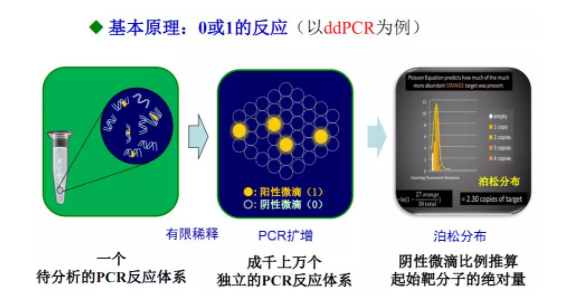
From the basic principles, it is not difficult to see that the biggest advantage of DdPCR is absolute quantification, which is expressed as:
· Absolute quantification - ddPCR technology can provide absolute counts of target DNA copies for each input sample without inputting a standard curve, making this technology ideal for target DNA measurement, viral load analysis and microbial quantification;
·High precision – the large number of sample assignments provided by ddPCR can reliably measure small differences in the copy number of the target DNA sequence in the sample;
·Improved signal-to-noise ratio - Dilute high-copy templates and background, effectively enrich the template concentration in the target-positive partition, so that rare targets can be ·sensitively detected, and quantitative accuracy of ±10% can be achieved, the sensitivity can reach a single nucleic acid molecule, and the detection limit As low as 0.001%;
·Eliminate PCR bias - Eliminate qPCR amplification efficiency dependence, reduce the error rate, and detect small (1.2 times) differences, here it should be pointed out;
·Reduced consumable costs - Reaction volumes in the picoliter to nanoliter range reduce reagent usage and sample volume per data point, especially for precious samples;
·Excellent partitioning -ddPCR technology can generate 20,000 droplets per 20 µl sample, and nearly 2 million partitioned PCR reactions can be performed on a 96-well plate. The more partitions, the higher the precision.
Service Application
DdPCR technology has many applications. According to the fields of published articles, we can simply divide them into:
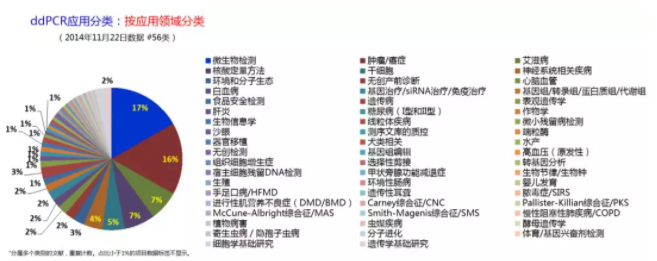
Combined with the field of tumors, we generally have 4 applications related to it:
1. Detection of Gene Expression, mainly quantitative analysis of mRNA detection;
2. Detect Mutation (SNV and Indel), can detect copy number, and can also detect ratio;
3. Detection of CNV (copy number variation analysis), relative quantification;
4. Detect Fusion, can detect the copy number, and can also detect the ratio;
Case presentation
Similarly, Reqbio Biotech also develops corresponding detection kits for these four applications, supporting Reqbio Biotech’s reference products, and evaluates the performance of the kits. Let’s take EGFR T790M as an example:
Experiment 1: Sensitivity Test
Samples to be tested: EGFR T790M standard products with different %AF, followed by 5%, 2%, 1%, 0.5%, 0.2%, 0.1%.
First of all, we choose 50% EGFR T790M standard product (CBP10402), the standard product is through gene editing, two alleles, CN=2, editing one as mutation, one as WT, after theoretical value calculation, Sanger sequencing, Bio- The Rad DdPCR kit (Assay ID: dHsaCP2000019) was co-validated and confirmed to be a frequency of 50%. Then use the gDNA of the corresponding host cell, and limit dilution to 5%, 2%, 1%, 0.5%, 0.2%, 0.1% according to the mass ratio (Qubit 3.0 three quantification average), prepare 3 replicates for each sample, total The corresponding frequency of 18 samples tested in the same experiment.
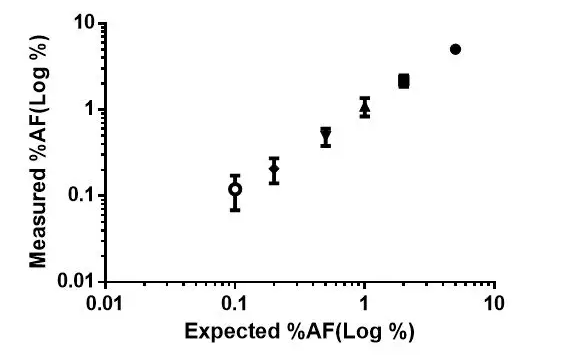
The corresponding data is:
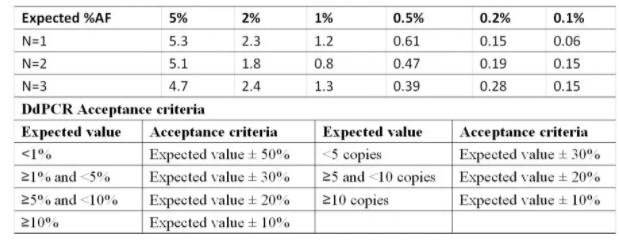
It can be seen from the above data that the EGFR T790M detection system can detect 0.1% and meets the standard, but the fluctuation is relatively large. In addition, during the experiment, we found that although DdPCR can theoretically generate 20,000 droplets, many experiments have shown that the actual generation is often lower than this value, with an average of about 8,000-10,000 droplets. The frequency of 0.1% may fluctuate greatly, affecting the judgment of the true value.
Experiment 2: Repeatability Test
Samples to be tested: Take 1% and 0.1% EGFR T790M standard products, divide them into 8 parts, add 10ng of sample to each part, and complete the corresponding calibration in one experiment.
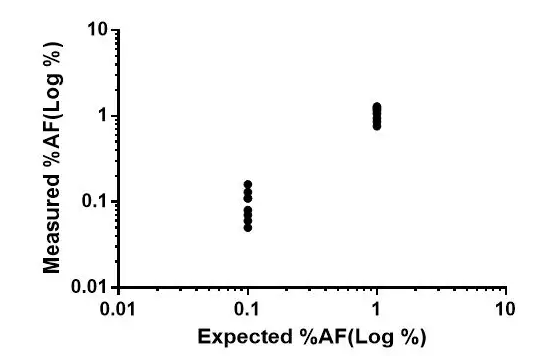
The corresponding data is:

It can be seen from the above data that the EGFR T790M detection system is stable and repeatable, and all can be detected.
Similarly, we have also developed some DdPCR kits for Gene Expression (mRNA), CNV and Fusion. Using Reqbio’s unique standard products, we have performed performance evaluations and launched a variety of products one after another. The following are the DdPCR kits we have launched The list of probes and primers are all verified on QX200:
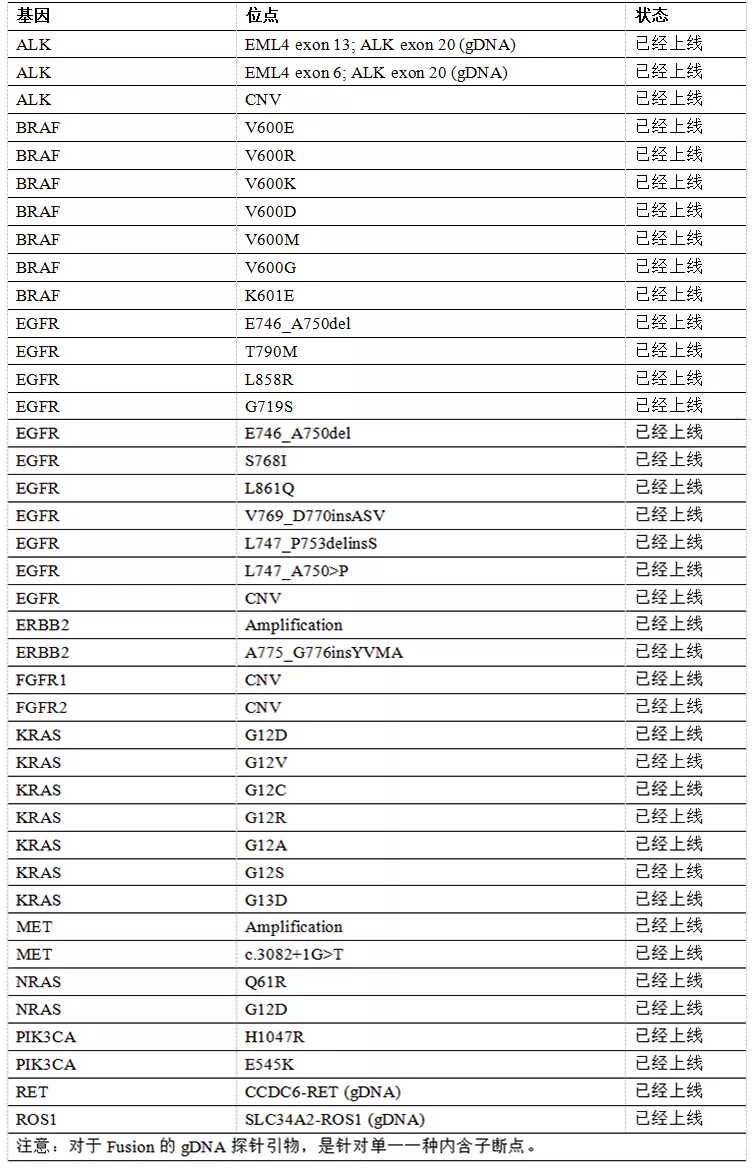
More DdPCR products can be developed and customized by Reqbio Biotech. We can not only develop custom probes and primers, but also standard products for verification system performance evaluation.
Ordering method
 Service Hotline:4008-750-250 Phone:180-6607-1954
Service Hotline:4008-750-250 Phone:180-6607-1954
 QQ:4008-750-250
QQ:4008-750-250  Mail:sales@reqbio.com
Mail:sales@reqbio.com